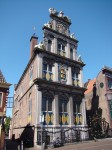 On the night of January 10th, 2005, four burglars broke into the Westfries Museum in Hoorn, northwestern Netherlands, on the night the museum celebrated its 125th anniversary, and stole 24 paintings and drawings and 70 silver objects from the museum’s collection. The market value of the stolen pieces was estimated at 10 million euros at the time, but believe it or not, the paintings weren’t insured. The museum had an excellent security system which did not appear to be damaged, but the alarm never went off and the burglary was only discovered by employees the next morning who arrived to find the place in a shambles with display cases shattered and paintings cut out of the frames. The damage to the museum facilities was in the millions of euros.
On the night of January 10th, 2005, four burglars broke into the Westfries Museum in Hoorn, northwestern Netherlands, on the night the museum celebrated its 125th anniversary, and stole 24 paintings and drawings and 70 silver objects from the museum’s collection. The market value of the stolen pieces was estimated at 10 million euros at the time, but believe it or not, the paintings weren’t insured. The museum had an excellent security system which did not appear to be damaged, but the alarm never went off and the burglary was only discovered by employees the next morning who arrived to find the place in a shambles with display cases shattered and paintings cut out of the frames. The damage to the museum facilities was in the millions of euros.
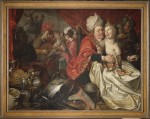 The stolen paintings date to the 17th and 18th centuries and include portraits, landscapes, cityscapes, still lifes, allegories and maritime scenes, by well-known Dutch Golden Age artists like Jan van Goyen, Jacob Waben and Matthias Withoos. The burglars had suspiciously fine taste, selecting the most important paintings in the collection which suggests careful premeditation. This is usually where the eternal chimera of the museum heist gets bruited about, ie, that the theft was commissioned by an underworld collector or dealer with a specific looting list, a perpetually popular theory that never seems to pan out in real life. Art thieves do the research and pick the most valuable stuff because they think they can sell it for the best price. That doesn’t mean they have a shadowy villain in a volcano lair directing their movements, or even a sure buyer lined up. More often than not they wind up sitting on the unmovable works for years because nobody wants to touch pieces that are so obviously hot.
The stolen paintings date to the 17th and 18th centuries and include portraits, landscapes, cityscapes, still lifes, allegories and maritime scenes, by well-known Dutch Golden Age artists like Jan van Goyen, Jacob Waben and Matthias Withoos. The burglars had suspiciously fine taste, selecting the most important paintings in the collection which suggests careful premeditation. This is usually where the eternal chimera of the museum heist gets bruited about, ie, that the theft was commissioned by an underworld collector or dealer with a specific looting list, a perpetually popular theory that never seems to pan out in real life. Art thieves do the research and pick the most valuable stuff because they think they can sell it for the best price. That doesn’t mean they have a shadowy villain in a volcano lair directing their movements, or even a sure buyer lined up. More often than not they wind up sitting on the unmovable works for years because nobody wants to touch pieces that are so obviously hot.
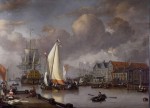 That appears to have been the pattern in the Westfries Museum heist too. For years museum and city officials sought the paintings to no avail. Last year they finally got their first big break in the case: a picture of one of the stolen paintings was found on a Ukrainian website. In July of this year, two people representing the ultra-right Organization of Ukrainian Nationalists (OUN) militia informed Dutch embassy officials in Kiev that their battalion had all 24 of the stolen paintings. They offered proof in the form of a classic from the kidnapper’s handbook: a picture of one of the paintings next to a current Ukrainian newspaper. They also claimed to have the stolen silverware, but they made no offer proof.
That appears to have been the pattern in the Westfries Museum heist too. For years museum and city officials sought the paintings to no avail. Last year they finally got their first big break in the case: a picture of one of the stolen paintings was found on a Ukrainian website. In July of this year, two people representing the ultra-right Organization of Ukrainian Nationalists (OUN) militia informed Dutch embassy officials in Kiev that their battalion had all 24 of the stolen paintings. They offered proof in the form of a classic from the kidnapper’s handbook: a picture of one of the paintings next to a current Ukrainian newspaper. They also claimed to have the stolen silverware, but they made no offer proof.
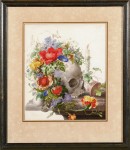 The militia men said the paintings were discovered in a villa that once belonged to cronies of the former Ukrainian president. Brand finds this backstory just a tad too convenient to be believable since it relies on the militia just happening to find a treasure trove of art stolen a decade ago in the home of its political enemies. Boris Goemenjoek, deputy commander of the volunteer OUN battalion, offered the art. He was acting under orders from the Oleg Tjagnibok, leader of the far right nationalist political party Svoboda. Brand believes Valentin Nalivaitsjenko, former head of the Ukrainian secret service is also involved.
The militia men said the paintings were discovered in a villa that once belonged to cronies of the former Ukrainian president. Brand finds this backstory just a tad too convenient to be believable since it relies on the militia just happening to find a treasure trove of art stolen a decade ago in the home of its political enemies. Boris Goemenjoek, deputy commander of the volunteer OUN battalion, offered the art. He was acting under orders from the Oleg Tjagnibok, leader of the far right nationalist political party Svoboda. Brand believes Valentin Nalivaitsjenko, former head of the Ukrainian secret service is also involved.
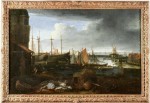 The militia was willing to arrange a return of the paintings on condition that the Ukrainian police not be involved (page two of the kidnapper’s handbook). The embassy told the Dutch police and the municipal authorities of Hoorn were given the chance to negotiate directly with the militia. Aware that dealing with armed criminal organizations was a tad beyond their purview, the city officials enlisted the aid of a professional art investigator Arthur Brand.
The militia was willing to arrange a return of the paintings on condition that the Ukrainian police not be involved (page two of the kidnapper’s handbook). The embassy told the Dutch police and the municipal authorities of Hoorn were given the chance to negotiate directly with the militia. Aware that dealing with armed criminal organizations was a tad beyond their purview, the city officials enlisted the aid of a professional art investigator Arthur Brand.
Brand noticed during the initial interactions that the present owners had a completely unrealistic idea of the value of the stolen paintings. They estimated the value at 50 million euros. Brand presented a research report to his Ukrainian contacts that showed that, based on recent auction proceeds of comparable works of the same painters, the entire collection should be estimated at a minimum of 250,000 euros and a maximum of 1.3 million euros, if in good condition. Because the latter did not appear to be the case, he estimated the current market value at no more than 500,000 euros.
On behalf of the municipality of Hoorn, Brand offered the militia a compensation, but received no response to the offer. The other party contended that a 5 million euro finder’s fee was in order and would not settle for less whereupon the municipality urged the ministry of Foreign Affairs to attempt to expedite the case along diplomatic channels. Talks on the highest political levels were held but to no avail. At present, there are serious indications that the current owners of the stolen art are attempting to sell it to others. Further research by Brand shows that other highly placed individuals are operating behind the scenes of the volunteer battalion. The stolen art is used as a pawn in a non-transparent Ukrainian political arena riddled with internal power struggles, favouritism and corruption.
With the art in danger of being sold out from under them, the Hoorn municipality and Westfries Museum have decided to drop the proverbial dime on these thieves. They’ve gone to the press and are making as big a stink as possible to stymie the OUM’s attempts at arranging a quick sale.
According to the museum director Ad Geerdink: “We have done everything we can and have reached a dead end. Now that it seems that the art works are disappearing again, we want to sound the alarm to let potential buyers know that they are dealing with stolen art, to give a correct representation of the actual value of the art works, but also to send a signal that these art works only belong in Hoorn. They are invaluable to the story we are telling about the extremely riveting period of the Golden Age in West Friesland.”
The Dutch Foreign Ministry has brought up the issue with Ukrainian politicians “at the highest level” and all this publicity might just light enough of a fire under them to burn through the power struggles, favoritism and corruption. The Ukrainian ambassador to The Netherlands contacted museum officials yesterday to tell them he would work to recover the works.